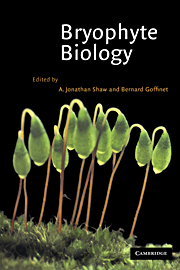Book contents
- Frontmatter
- Contents
- List of contributors
- Preface
- 1 Anatomy, development, and classification of hornworts
- 2 Morphology and classification of the Marchantiophyta
- 3 Morphology and classification of mosses
- 4 Origin and phylogenetic relationships of bryophytes
- 5 Chemical constituents and biochemistry
- 6 Molecular genetic studies of moss species
- 7 Control of morphogenesis in bryophytes
- 8 Physiological ecology
- 9 Mineral nutrition, substratum ecology, and pollution
- 10 Peatlands: ecosystems dominated by bryophytes
- 11 Role of bryophyte-dominated ecosystems in the global carbon budget
- 12 Population ecology, population genetics, and microevolution
- 13 Bryogeography and conservation of bryophytes
- Index
11 - Role of bryophyte-dominated ecosystems in the global carbon budget
Published online by Cambridge University Press: 05 June 2012
- Frontmatter
- Contents
- List of contributors
- Preface
- 1 Anatomy, development, and classification of hornworts
- 2 Morphology and classification of the Marchantiophyta
- 3 Morphology and classification of mosses
- 4 Origin and phylogenetic relationships of bryophytes
- 5 Chemical constituents and biochemistry
- 6 Molecular genetic studies of moss species
- 7 Control of morphogenesis in bryophytes
- 8 Physiological ecology
- 9 Mineral nutrition, substratum ecology, and pollution
- 10 Peatlands: ecosystems dominated by bryophytes
- 11 Role of bryophyte-dominated ecosystems in the global carbon budget
- 12 Population ecology, population genetics, and microevolution
- 13 Bryogeography and conservation of bryophytes
- Index
Summary
Introduction
There is growing consensus within the scientific community that increases in atmospheric methane (CH4) and carbon dioxide (CO2) are enhancing the earth's natural greenhouse effect. Because of the potential effects of these gases on the global energy budget and future climate, there is an urgent need to quantify terrestrial sources and sinks of carbon. Bryophytes are the primary form of carbon storage in many northern ecosystems. There is more carbon stored in Sphagnum and Sphagnum litter (150 × 1012 g) than in any other genus of plants, vascular or non-vascular (Clymo & Hayward 1982). Since the end of the last glacial period (∼ 18 000 y.b.p.), the soils of the northern latitudes have served as a reservoir for terrestrial carbon (Harden et al. 1992). Northern peatlands alone may contain two to three times the amount of carbon stored in tropical rainforests (Post et al. 1982, Gorham 1991). The majority of this carbon has been frozen in permafrost soils and sequestered from atmospheric circulation for thousands of years. On a warming planet, this carbon represents a “ticking time bomb” that could rapidly decompose and increase the amount of CO2 in the atmosphere by as much as 50% (Billings 1997, Goulden et al. 1998). Predicting how the vast stores of soil carbon in moss-dominated ecosystems will be affected by anthropogenic disturbance is critical for models of global climate change.
- Type
- Chapter
- Information
- Bryophyte Biology , pp. 344 - 368Publisher: Cambridge University PressPrint publication year: 2000
- 34
- Cited by



